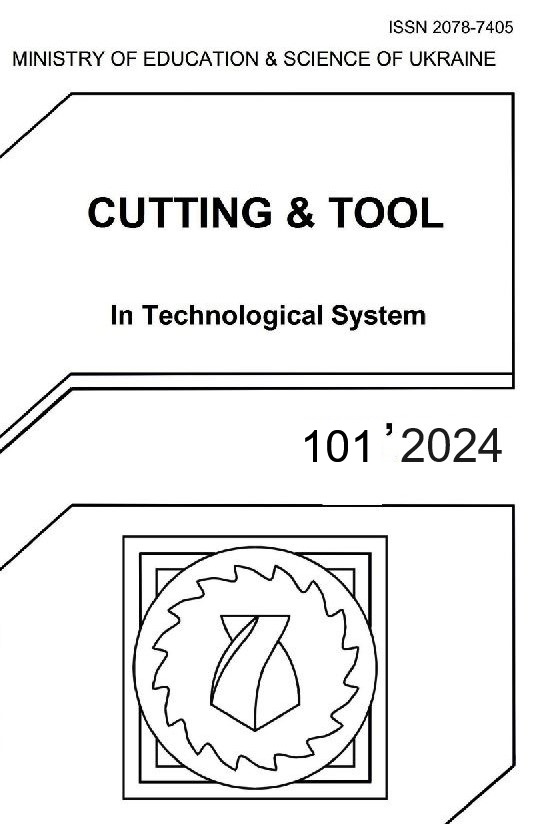THE INFLUENCE OF DIFFERENT HARDNESS OF THE TOOL MATERIAL ON THE WEAR OF SHM GRINDING WHEELS AND THE SPECIFIC ENERGY INTENSITY OF GRINDING
DOI:
https://doi.org/10.20998/2078-7405.2024.101.02Keywords:
hardness, high-speed steels, hard alloys, ceramics, wear of SHM grinding wheels, specific energy intensity of processingAbstract
It was established that conditionally viscous-brittle tool materials (high-speed steels and hard alloys) behave in the same way with an increase in hardness: wheel wear and the specific energy consumption of their grinding decrease. As the hardness of brittle tool oxide-carbide ceramics increases, both wheel wear and the specific energy consumption of grinding, on the contrary, increase. That is, an increase in the hardness of viscous-brittle materials facilitates the separation of elementary chips, less energy is needed for this, and accordingly the wear of the wheel and the specific energy consumption of their grinding are reduced. On brittle ceramics, with increasing hardness, there is no change in chip removal, but harder sludge becomes more abrasive and, as a result, the wear of the wheel and the specific energy consumption of their grinding increase. The conclusion from the literature that hard and less plastic materials require relatively less specific energy for grinding is confirmed by us when comparing materials of approximately the same hardness - hard alloys and ceramics. In ceramics, the energy consumption of grinding is actually four times lower than that of hard alloys.
References
Synthetic superhard materials: V 3 т. Т. 1: Synthesis of Superhard Materials/ V.G. Aljoshin, V.D. Andreev, H.P. Bogatyrjova, S.A. Boszko; (Ed.) N.V. Novikov. (in Russian) Кyiv: Nauk. dumka, 1986. – 280 p.
Pozdnyak L.A. Instrumental Steels. (in Russian) Kyiv: Naukova dumka, 1996. – 487 p.
Schleifen von nichoxidishen keramischen Werkstoffen. Industrie Anzeigez. 1985. 107, N 53 (3). рр. 43–44.
Buttery T.C., Hamed M.S. Some factors affecting the efficiency of individual grits in simulated experiments. Wear. 1977. 44, N 2. рр. 231–245.
Initiation and evolution of wheel polygonal wear: Influence of wheel-rail hardness ratios / Wenjian Wang, Jinwei Huang, Haohao Ding, Zefeng Wen, Xiaolu Cui, Roger Lewis, Qiyue Liu. Wear. Volumes 540–541, 15 March 2024, 205255 https://doi.org/10.1016/j.wear.2024.205255
Jinxuan Zhu, Ramin Aghababaei. On the size effect in scratch and wear response of single crystalline copper. Tribology International. Volume 186, August 2023, 108573 https://doi.org/10.1016/j.triboint.2023.108573.
Experimental and theoretical investigation on the ductile removal mechanism in in-situ laser assisted diamond cutting of fused silica / Chuangting Lin, Wenbin He, Xiao Chen, Zhengding Zheng, Kai Huang, Weiqi Huang, Jianguo Zhang, Jianfeng Xu. Journal of Materials Research and Technology. Volume 24, May–June 2023, рр. 7704-7719 https://doi.org/10.1016/j.jmrt.2023.05.033 .
Lavrinenko V.I., Solod V.Yu. Determining the conditi¬ons for achieving the plastic regime of dia¬mond grinding of cera¬mics from the standpoint of estima¬ting energy costs of processing. Journal of Superhard Materials, 2023, Vol. 45, No. 1, pp. 65–71 https://doi.org/10.3103/S1063457623010070 .
Influence of diamond abrasives on material removal of single crystal SiC in mechanical dicing /Mian Li, Dekui Mu, Yueqin Wu, Guoqing Huang, Hui Meng, Xipeng Xu, Han Huang. Journal of Materials Processing Technology. Volume 327, June 2024, 118390 https://doi.org/10.1016/j.jmatprotec.2024.118390.
Specific energy modeling of abrasive cut off operation based on sliding, plowing, and cutting / Muhammad Rizwan Awan, Hernán A. González Rojas, José I. Perat Benavides. Saqib Hameed, Abrar Hussai, Antonio J. Sánchez Egea. Journal of Materials Research and Technology. Volume 18, May–June 2022, рр. 3302-3310 https://doi.org/10.1016/j.jmrt.2022.03.185.
Revolutionizing hardness via nanoparticle flux in welding of high-hardness armor steel / Chang Jong Kim, Young Cheol Jeong, Hwi Jun Son, Bo Wook Seo, Seok Kim, Sung-Ki Lyu, Xiangying Hou, Young Tae Cho. Materials & Design. Volume 242, June 2024, 113001 https://doi.org/10.1016/j.matdes.2024.113001.
Lavrinenko V.I. To the analysis of the es¬timate of energy expendi¬tures in the diamond abra¬sive treatment by wheels from superhard materials. Journal of Superhard Materials, 2022, Vol. 44, No. 4, pp. 285–291 https://doi.org/10.3103/S1063457622040050.
Downloads
Published
Issue
Section
License
Copyright Notice
Authors who publish with this Collection agree to the following terms:
1. Authors retain copyright and grant the Collection right of first publication with the work simultaneously licensed under a Creative Commons Attribution License that allows others to share the work with an acknowledgement of the work's authorship and initial publication in this Collection.
2. Authors are able to enter into separate, additional contractual arrangements for the non-exclusive distribution of the Collection's published version of the work (e.g., post it to an institutional repository or publish it in a book), with an acknowledgement of its initial publication in this Collection.
3. Authors are permitted and encouraged to post their work online (e.g., in institutional repositories or on their website) prior to and during the submission process, as it can lead to productive exchanges, as well as earlier and greater citation of published work.

